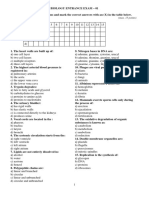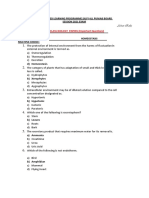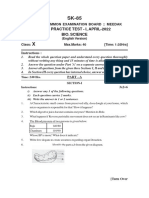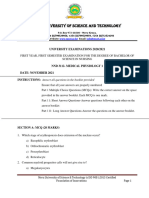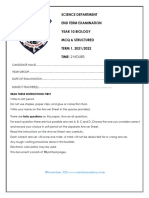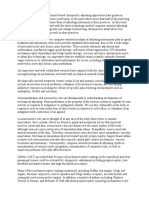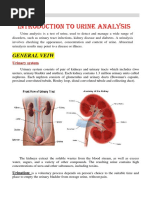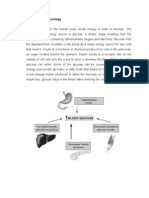ANATOMY ESE 1-1
ANATOMY ESE 1-1
Uploaded by
barakashega98Copyright:
Available Formats
ANATOMY ESE 1-1
ANATOMY ESE 1-1
Uploaded by
barakashega98Copyright
Available Formats
Share this document
Did you find this document useful?
Is this content inappropriate?
Copyright:
Available Formats
ANATOMY ESE 1-1
ANATOMY ESE 1-1
Uploaded by
barakashega98Copyright:
Available Formats
__________
MINISTRY OF HEALTH COMMUNITY DEVELOPMENT GENDER ELDERS AND CHILDREN
TANGANYIKA MEDICAL TRAINING BOARD
TABORA INSTITUE
BASIC TECHNICIAN CERTIFICATE IN CLINICAL MEDICINE
(NTA LEVEL 4)
END OF SEMISTER I EXAMINATION
MODULE CODE: CMT 04102
MODULE NAME: ANATOMY AND PHYSIOLOGY
MARCH 2016
TIME: 2: 00 HOURS DATE……………………….
GENERAL INSTRUCTIONS:
1. Read all instructions carefully.
2. Write your examination number on each page of the answer sheet you use.
3. Attempt all questions.
4. Cellular phones are NOT allowed in the examination room.
5. Each essay question to be answered on not more than 3 hand written papers.
6. This paper consists of five (5) sections.
7. The table below is for OFFICIAL USE ONLY
SECTION TYPE OF QUESTIONS MARKS ALLOCATION SCORED MARKS
A MULTIPLE CHOICE 10
B MULTIPLE TRUE/FALSE 10
C MATCHING 10
D SHORT ANSWER 40
E GUIDED ESSAY 30
TOTAL 100
ANATOMY AND PHYSIOLOGY Page 1
SECTION I: MULTIPLE CHOICE QUESTIONS (10 Marks)
Answer all questions
Circle the most correct response
1. Basing on gross appearance the bone tissue is classified as;
a. Long bones, compact bone and short bones
b. Long bones, short bones and flat bones
c. Compact bones, short bones and spongy bones
d. Long bones, short bones and spongy bones
e. Bone marrow bones, compact bones and flat bones
2. The most extracellular electrolytes is;
a. Calcium
b. Potassium
c. Magnesium
d. Fluorine
e. Zinc
3. Anatomy is;
a. Examination of the structural features of cells using a microscopy.
b. The study of tissues, which are cells and the material surrounding them.
c. The science of the chemical, physical and biochemical functions of humans in good health, their
organs and the cells of which they are composed.
d. It is a study of structure of the body and physical relationship involved in between body system.
e. The study of cellular and body structures functions
4. Formed elements of blood are;
a. Erythrocytes, leucocytes and platelets.
b. Plasma, erythrocytes and platelets.
c. Erythrocytes and platelets only.
d. Plasma, leucocytes and platelets.
e. Electrolytes, Platelets and erythrocytes
5. The structures found in the superior mediastinum;
a. Trachea, esophagus, and thymus.
b. Left and right lungs, esophagus, and trachea
c. Right lung, thoracic duct, vagus nerve and phrenic nerve
d. Manubrium, heart, esophagus and trachea
e. Thymus, right lung, kidneys and spleen
ANATOMY AND PHYSIOLOGY Page 2
6. Glycolysis takes place in
a. The cytoplasm of a cell
b. The nucleus of a cell
c. The plasma membrane
d. The mitochondria
e. The golgi apparatus
7. The principal organ in the digestive system is the;
a) Ureter
b) Urinary bladder
c) intestines
d) Urethra
e) None of above
8. The process by which your body converts what you eat and drink into energy is known as
a) Metabolic pathway
b) Catabolism
c) Anabolism
d) Metabolism
e) Glycogenolysis
9. The following are three major parts of the colon EXCEPT
a) Ascending colon
b) Descending colon
c) Transverse colon
d) Renal cortex
e) None of above
10. The following is association with low incidence of heart disease;
a) Very low density lipoprotein
b) Low density lipoprotein
c) High density lipoprotein
d) Mild density lipoprotein
e) Very high density lipoprotein
ANATOMY AND PHYSIOLOGY Page 3
SECTION II: TRUE/FALSE SESSION (10 MARKS)
Answer all questions
Write the word TRUE for true statement and FALSE for false statement
1/2 a mark will be awarded for the correct answer
1. Concerning the structures of the heart
a)........................ it is divided into five chambers
b)........................ An average size is approximately 11cm by 7cm by 3cm
c)........................ it is located into the right side of the thoracic cavity
d)........................ the heart has six chambers
e)....................... The heart is covered by a thin connective tissue membrane called CAPSULE
2. Specialized connective tissue consists of ;
a) _________adipose tissue.
b) _________blood tissue and lymphatic tissue
c) _________cartilage and bone tissue
d) _________loose connective tissue.
e) _________nervous tissue and squamous tissue
3. The accessory organs of the respiratory system includes the following
a)........................ The mouth
b)........................ The ureters
c)........................ Urinary bladder
d)........................ intestines
e)........................ The prostate
4. About major body fluid compartments;
a) __________Extracellular compartment is the largest one
b) __________Intracellular compartment is the largest one
c) __________Extracellular fluid is about 40% of the body weight.
d) __________Intracellular fluid is about 20% of the body weight.
e) __________Interstitial fluid is large compared to intracellular fluid
ANATOMY AND PHYSIOLOGY Page 4
SECTION B
I. MULTIPLE TRUE AND FALSE QUESTIONS (10 MARKS)
II. WRITE THE WORD TRUE FOR THE TRUE STATEMENT AND THE WORD FALSE FOR
THE FALSE STATEMENT ON THE SPACE PROVIDED
PART I
A. BLOOD CELLS B. FUNCTIONS
1 Thrombocytes ………. A CD4+ T cells coordinate the immune response and CD8+
are cytotoxic virus and tumor cells
2 Neutrophils …………. B Transport O2 and Co2 to and from the body tissues
3 Eosinophil……………. C Control bleeding by forming a plug
4 Monocytes…………… D Phagocytosis of bacteria or fungal infections
5 Macrophages………… E Deals with parasitic infections
F Vacuum leaner
G Engulfing food particles
II. Match the items in column A against the items in column B
Column A Column B
1. Submandibular lymph A. glycerol
nodes…………...
2. Circulusarteriosus……… B. Mandibular area
3. Inguinal lymph nodes C. Inguinal area
4. Cervical lymhph nodes…… D. Pulse rate
5. Radial pulse……….. E. Circle of willis
6. Renal artery…….. F. Renal blood supply
7. Pedisdorsailis pulse………. G. Dorsal part of foot
8. Protein……….. H. Pepsin
9. Fat………………… I. Aminol acid and grycerol
10. Carbohydrates……………….
J. Physical barrier between lumen and
epithelium
K. Inhibit gastric acid secretion
L. Complexes with vitamin B12 to permit
absorption
F Digest protein
G. Digest fats
ANATOMY AND PHYSIOLOGY Page 5
SECTION D: SHORT ANSWER QUESTIONS (40 MARKS)
Answer all questions
Write your responses in the space provided
Use readable handwriting
1. Mention two types of cells which form the alveolar wall and their functions
i. ………………………………………………………………………………………
ii. ………………………………………………………………………………………
Mention three vessel which forms the circle of willis
i. ………………………………………………………………………………………
ii. ………………………………………………………………………………………
iii. ………………………………………………………………………………………
2. Mention five functions of the stomach;
i. ………………………………………………………………………………………
ii. ………………………………………………………………………………………
iii. ………………………………………………………………………………………
iv. ………………………………………………………………………………………
v. ………………………………………………………………………………………
3. List five(5) organs found in the mediasternum
i. ………………………………………………………………………………………
ii. ………………………………………………………………………………………
iii. ………………………………………………………………………………………
iv. ………………………………………………………………………………………
v. ………………………………………………………………………………………
4. Mention five functions of the pharynx
i. ……………………………………………………………………………………..
ii. ……………………………………………………………………………………..
iii. ……………………………………………………………………………………..
iv. ……………………………………………………………………………………..
v. ……………………………………………………………………………………..
ANATOMY AND PHYSIOLOGY Page 6
5. Concerning functions of the blood circulation. Briefly explain the following;
i. systole
………………………………………………………………………………………………………
………………………………………………………………………………………………..
ii. Diastole
………………………………………………………………………………………………………
……………………………………………………………………………………………………
iii. Pulse
…………………………………………………………………………………………………….
iv.
……………………………………………………………………………………………………
Peristalsis
v. ………………………………………………………………………………………………………
………………………………………………………………..
6. Outline any five (5) of the main functions of the liver
i. …………………………………………………………………………………
ii. …………………………………………………………………………………
iii. ………………………………………………………………………………….
iv. ………………………………………………………………………………….
v. ………………………………………………………………………………….
7. Mention the organs of breathing
i. ………………………………………………………………………………
ii. ………………………………………………………………………………
iii. ……………………………………………………………………………….
iv. ……………………………………………………………………………….
v. ………………………………………………………………………………..
8. Outline five (5) endocrine glands that are involved in control of glucose metabolism
i. ………………………………………………………………………………
ii. ………………………………………………………………………………
iii. ………………………………………………………………………………
iv. ………………………………………………………………………………
v. ………………………………………………………………………………
ANATOMY AND PHYSIOLOGY Page 7
SECTION E: GUIDED ESSAY QUESTIONS (30 MARKS)
Answer all questions
Each question carries 15 marks
1. Briefly describe the portai circulation
2. Describe the mechanism of breathing
ANATOMY AND PHYSIOLOGY Page 8
You might also like
- The University of Auckland: Incourse Test 2015 Biological Sciences Biology For Biomedical ScienceDocument31 pagesThe University of Auckland: Incourse Test 2015 Biological Sciences Biology For Biomedical Scienceqwwqwwqwqwwqwwq0% (2)
- Lab Instructions Heart Dissection (Pig)Document6 pagesLab Instructions Heart Dissection (Pig)Sandy HernandezNo ratings yet
- Biology KISA Preparatory Paper 2023Document5 pagesBiology KISA Preparatory Paper 2023Ruchira Sanket Kale83% (6)
- Anatomy and Physiology TestDocument5 pagesAnatomy and Physiology TestPao Parel100% (1)
- ENTRANCE TEST - BIOLOGY For 2018/2019 Academic Year at Medical Faculty, Trakia University, Stara ZagoraDocument6 pagesENTRANCE TEST - BIOLOGY For 2018/2019 Academic Year at Medical Faculty, Trakia University, Stara ZagoraNia BoyadzhievaNo ratings yet
- EMT B Study Guid2Document11 pagesEMT B Study Guid2varela86100% (2)
- Question Paper: Sections Type of Questions Marks Allocated Marks Scored Tutor SignDocument7 pagesQuestion Paper: Sections Type of Questions Marks Allocated Marks Scored Tutor SignAbdul MalikNo ratings yet
- namma_kalvi_11th_biology_full_portion_model_question_papers_em_217387Document7 pagesnamma_kalvi_11th_biology_full_portion_model_question_papers_em_217387mohamedrafeekaliNo ratings yet
- Bio Test 1 eDocument3 pagesBio Test 1 eroseNo ratings yet
- 11th STD Biology Important QuestionsDocument9 pages11th STD Biology Important QuestionsPeriyasamy NNo ratings yet
- Anatomy Cat 1 ADocument8 pagesAnatomy Cat 1 AFrankdavid07No ratings yet
- Anatomy Qn Paper Theory I-1Document9 pagesAnatomy Qn Paper Theory I-1barakashega98No ratings yet
- Class 8 Half Yearly 24-25 BIODocument2 pagesClass 8 Half Yearly 24-25 BIOTasdidaa ShamsiNo ratings yet
- 12th Bio Important ALPDocument15 pages12th Bio Important ALPAdnan RafiqNo ratings yet
- _Anatomy complete, Proteins, Introduction to Micro-1Document3 pages_Anatomy complete, Proteins, Introduction to Micro-1Aleena MasoodNo ratings yet
- Hauman-anatomy-and-Physiology-Sample-paper-2021-pdf-HAP-Sample-paper-2021-pdfDocument2 pagesHauman-anatomy-and-Physiology-Sample-paper-2021-pdf-HAP-Sample-paper-2021-pdfmahendra singh bhatiNo ratings yet
- 8 Bio T1 RevDocument14 pages8 Bio T1 Revnethumleesanodya2007No ratings yet
- Preliminary Examm ,Updated Biology Quation Paper for 12thDocument3 pagesPreliminary Examm ,Updated Biology Quation Paper for 12thpatilshreyash35No ratings yet
- 36 Biology QpDocument7 pages36 Biology QplavanyahsnaikNo ratings yet
- Anatomy Exam End of Semster 1 - 080415Document6 pagesAnatomy Exam End of Semster 1 - 080415bravin787No ratings yet
- 10th Bio - Science em-SK-85Document4 pages10th Bio - Science em-SK-85AKHIL VARDHAN KAMAL SAINo ratings yet
- Anatomy Test-2Document4 pagesAnatomy Test-2dianadorispatrickNo ratings yet
- Nnu 3112 Medical Physiology I 1Document6 pagesNnu 3112 Medical Physiology I 1bosco kiuriaNo ratings yet
- BIOLOGY MODEL PAPER 9thDocument3 pagesBIOLOGY MODEL PAPER 9thHasnain Ahmad KhanNo ratings yet
- (WWW - Entrance-Exam - Net) - ICSE Class 10 Sample Paper 3Document4 pages(WWW - Entrance-Exam - Net) - ICSE Class 10 Sample Paper 3AshwinNo ratings yet
- Final KSKtests 1-10 En-FinallDocument48 pagesFinal KSKtests 1-10 En-Finallly nguyendoanNo ratings yet
- CCM 3122 Human Anatomy IDocument6 pagesCCM 3122 Human Anatomy Iy mugambiNo ratings yet
- BiologyDocument1 pageBiologynavyamanikarnikaNo ratings yet
- Bio 9thDocument2 pagesBio 9thjahanzaibNo ratings yet
- Rev2 PhysiologyDocument3 pagesRev2 PhysiologyIggaNo ratings yet
- Biology Form Three Annual 2023Document6 pagesBiology Form Three Annual 2023vecema1296No ratings yet
- s4 Biology Paper 1 Set 9Document10 pagess4 Biology Paper 1 Set 9David NalodaNo ratings yet
- S1 Biology1Document13 pagesS1 Biology1izomadman392No ratings yet
- Chapter 002 QuestionsDocument17 pagesChapter 002 QuestionsCaitlin EsguerraNo ratings yet
- UP Association of Biology Majors Bio 11 ReviewerDocument7 pagesUP Association of Biology Majors Bio 11 ReviewerLoeyNo ratings yet
- END OF SEM ANATOMY (1)-1Document8 pagesEND OF SEM ANATOMY (1)-1Michael nyunjaNo ratings yet
- Final Prototype NMCZ June 2024 Exam 1111Document17 pagesFinal Prototype NMCZ June 2024 Exam 1111JONES MUNANo ratings yet
- Cat 2 Pathology FNL - New1Document8 pagesCat 2 Pathology FNL - New1helgajosiah2No ratings yet
- Biology Mid-term f3 2024.DocDocument4 pagesBiology Mid-term f3 2024.Docmohammadavuru49No ratings yet
- Field of SpecializationDocument18 pagesField of SpecializationAiza AbdNo ratings yet
- Exams - Anatomy and Physiology (Pp1)Document4 pagesExams - Anatomy and Physiology (Pp1)emmabitutu5No ratings yet
- Biology SSC II SolutionDocument13 pagesBiology SSC II SolutionMahwishbukhariNo ratings yet
- MC 1 HUMAN ANATOMY AND PHYSIOLOGY MidtermDocument12 pagesMC 1 HUMAN ANATOMY AND PHYSIOLOGY MidtermNicole Sheen EnriquezNo ratings yet
- KISA -Prep-Biology-1 5Document5 pagesKISA -Prep-Biology-1 5saanvishettyasdNo ratings yet
- Strictly No Erasures.: 1St Long Quiz /// Practical Nursing /// Module 1 and Module 2 /// Set ADocument7 pagesStrictly No Erasures.: 1St Long Quiz /// Practical Nursing /// Module 1 and Module 2 /// Set AOneLove 2ShopNo ratings yet
- BIOLOGY II FBI1224 2022 Question Paper 1Document10 pagesBIOLOGY II FBI1224 2022 Question Paper 1zoulzz0903No ratings yet
- PHYSIOLOGY POST PAPER 1Document16 pagesPHYSIOLOGY POST PAPER 1salimmafanyaNo ratings yet
- 2018 Mlb133 Final ExamDocument18 pages2018 Mlb133 Final ExamJADENo ratings yet
- BiologyDocument7 pagesBiologyjaiNo ratings yet
- Bio class 11Document4 pagesBio class 11puspakn0No ratings yet
- Q.P. Code: 526051Document15 pagesQ.P. Code: 526051Balamurugan PanneerselvamNo ratings yet
- Q.P. Code: 526051Document17 pagesQ.P. Code: 526051Bharath RajNo ratings yet
- Q.P. Code: 526051Document19 pagesQ.P. Code: 526051maddy333787No ratings yet
- Anatomy End of 1ST Year Jan 07-1Document7 pagesAnatomy End of 1ST Year Jan 07-1chobeledorisNo ratings yet
- 2017 P2 MuarDocument8 pages2017 P2 MuarNorbert LimNo ratings yet
- Year 10 BiologyDocument15 pagesYear 10 BiologylkipsangNo ratings yet
- BLEPT - Bio - Morphology Anatomy and PhysiologyDocument151 pagesBLEPT - Bio - Morphology Anatomy and PhysiologyJAYSON RAMOSNo ratings yet
- Anp 400 P2Document13 pagesAnp 400 P2Safwan_Idham_B_5749No ratings yet
- 27 Jan 2024 CJMADocument6 pages27 Jan 2024 CJMAtourayadam419No ratings yet
- Science Grade 8 T3 Revision Mock Ans KeyDocument13 pagesScience Grade 8 T3 Revision Mock Ans Keyahmed5030 ahmed5030No ratings yet
- Kluang, JohorDocument8 pagesKluang, JohorJolene ChiaNo ratings yet
- Salanki Proadjuster ArticleDocument3 pagesSalanki Proadjuster ArticleMatt GoldmanNo ratings yet
- Principles of HomeostasisDocument31 pagesPrinciples of Homeostasisleeminhoangrybird100% (3)
- All About Puberty SRC PDocument52 pagesAll About Puberty SRC PAbdul MalikNo ratings yet
- Arijo's Biology PDFDocument48 pagesArijo's Biology PDFAamir MengalNo ratings yet
- Anatomy Tables-Nerves of The Head and NeckDocument36 pagesAnatomy Tables-Nerves of The Head and NeckTracie YWNo ratings yet
- Biology Weekly Worksheet g7s2pb Transport in HumansDocument5 pagesBiology Weekly Worksheet g7s2pb Transport in HumansD'ferti AnggraeniNo ratings yet
- MAGCAR 12 - Cardiopatías CongénitasDocument61 pagesMAGCAR 12 - Cardiopatías CongénitasMovil Maria 2No ratings yet
- Introduction To Urine Analysis: General VeiwDocument8 pagesIntroduction To Urine Analysis: General Veiwبلسم محمود شاكرNo ratings yet
- Mechanical AsphyxiaDocument73 pagesMechanical Asphyxiaapi-61200414No ratings yet
- GlomerulopatiDocument16 pagesGlomerulopatiFitri Murpiana MuntheNo ratings yet
- Rubbing The Abdomen To Aid The StomachDocument2 pagesRubbing The Abdomen To Aid The Stomachheroig100% (1)
- Katishoola LumbagoDocument4 pagesKatishoola LumbagoRajiv SharmaNo ratings yet
- Physical Examination (Cephalocaudal Approach)Document7 pagesPhysical Examination (Cephalocaudal Approach)charedlumbaNo ratings yet
- Denis Scales: Name and SynonymsDocument8 pagesDenis Scales: Name and SynonymsBeata Dinda SeruniNo ratings yet
- Exercise 1: Label and Explain The Blood CirculationDocument2 pagesExercise 1: Label and Explain The Blood CirculationKiana Ramosa100% (2)
- LeukemiasDocument3 pagesLeukemiasAli TARARNo ratings yet
- B-Cell DevelopmentDocument85 pagesB-Cell Developmentعلي عايد عبدالشهيدNo ratings yet
- Congenital Hemifacial HiperplasiaDocument4 pagesCongenital Hemifacial HiperplasiaayuNo ratings yet
- Anatomy and PhysiologyDocument13 pagesAnatomy and PhysiologyernestoNo ratings yet
- 800 Questions PDFDocument256 pages800 Questions PDFDrBhawna Arora100% (1)
- Dr. Khairun Nisa, Mkes., AIFO Fakultas Kedokteran Universitas Lampung 2014Document35 pagesDr. Khairun Nisa, Mkes., AIFO Fakultas Kedokteran Universitas Lampung 2014Dhita Dwi NandaNo ratings yet
- DIT 2010 Content IndexDocument2 pagesDIT 2010 Content Indexmone2222No ratings yet
- Exocrine GlandsDocument24 pagesExocrine GlandsKrishma ShakyaNo ratings yet
- Life ProcessesDocument22 pagesLife ProcessesitsmelilysnowNo ratings yet
- Adrenal InsufficiencyDocument10 pagesAdrenal InsufficiencyKhalil DiabNo ratings yet
- Nursing Care Plans For Cruris Fracture: Case 1Document9 pagesNursing Care Plans For Cruris Fracture: Case 1susanti santaliaNo ratings yet
- Salma (Sameer)Document16 pagesSalma (Sameer)Sahil HussainNo ratings yet
- Assignment of Adrenal CortexDocument12 pagesAssignment of Adrenal CortexWania AliNo ratings yet








